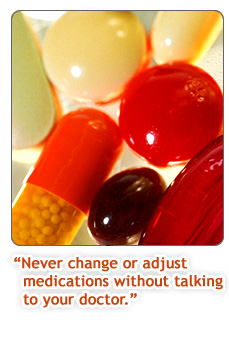  You’ve seen the television commercials proclaim that a purple pill can soothe your heartburn. Have allergies? Maybe a hot male windsurfing through a corn field will get you to buy the latest sinus-clearing drug. What if you’re depressed? Have herpes or headaches, incontinence or impotence? Expensive ads try to entice you with enormously expensive medications for all of those maladies.
That’s because we’re a nation of drug takers, popping over-the-counter (OTC) and prescription medications in record numbers. About 45% of Americans used at least one prescription drug in the past month, according to the National Center for Health Statistics. Odds are you’ll leave each doctor visit with recommendations to take an average of 2.2 drugs.
That’s not necessarily a bad thing. Medications give countless people pain-easing, lifesaving, and quality-of-life enhancing help. On the other hand, medical costs have soared in recent years, and the increasing cost of prescription drugs can cause more than just financial problems for those who need them. High out-of-pocket medication expenses too often tempt patients to skip their drugs -- or not take them at all. According to the University of Michigan School of Public Health and the Arbor Research Collaborative, Americans pay the highest out-of-pocket drug costs in the world, and even those who can afford their prescription drugs are far less likely to take them than patients in other countries.
Fortunately, comparing medication choices, taking drugs as prescribed, and talking to your doctor and pharmacist can help keep your body and bank account as healthy as possible. A case in point: there are safe, effective, and cheaper generic equivalents for most widely prescribed brand name drugs.
"Consumers should educate themselves about alternatives," says J. Douglas Bremner, MD, professor of psychiatry and radiology at Emory University School of Medicine in Atlanta and author of Before You Take That Pill, a guide to understanding the pros and cons of medications. "There is a natural tendency among the pharmaceutical industry to promote brand name products, but that isn't always in the consumer's interest. In the absence of any evidence that one drug works better than another, always use a generic."
 Best buys for commonly prescribed medicinesHere’s another resource to help you make wise drug choices. Consumer Reports recently issued a "Best Buy Drugs" report, listing effective and safe drugs that provide the best value for your healthcare dollar. What follows are examples of their top recommendations for some of the most common health problems:
Hypertension, the medical term for high blood pressure, is nothing to ignore. A "silent killer," undiagnosed and untreated high blood pressure can lead to stroke, heart attack, heart failure, or kidney failure. Fortunately, several classes of medicines, sometimes taken in combination, can effectively control hypertension:
- Beta-blockers. The cost for these blood pressure drugs varies, from around $10 for a generic version to over $250 a month for some brand name drugs. Stick with the generics (metoprolol tartrate, nadolol, and propranolol). You may save up to $2,000 a year.
- Calcium channel blockers. All calcium channel blockers, which lower blood pressure and treat angina, are available under high-priced brand labels and cheaper generics. Opt for a generic version and your cost could be closer to $22 a month (as opposed to $120 for brand name drugs).
- ACE inhibitors. These drugs treat high blood pressure, heart failure, diabetes, and kidney disease. Generic versions (benazepril, enalapril, captopril, and lisinopril) -- and one moderately priced brand name drug, ramipril (Altace) -- are all effective. They can save you more than $100 a month over high-priced brand name drugs.
Depression comes in several forms. Not everyone needs medication, but people with serious depression do. Costs for commonly prescribed antidepressants range from $32 a month to more than $200. If you suffer from serious depression, ask your doctor about generic fluoxetine (instead of Prozac). At a dose of 10 - 20 mg, taken once a day, fluoxetine costs about $37 a month. Brand named citalopram (Celexa) costs about $50 a month. Meanwhile, bupropion (Wellbutrin), at 75 - 100 mg three times a day, can cost around $71 a month. Here’s another money-saving hint: talk to your doctor about starting at the lowest dosage. A lower dose may minimize your risk for side effects and work just as well, or better, than a higher one -- while costing less. (Of course, never adjust your medications on your own.)
People with type 2 diabetes, primarily a lifestyle disease caused by excess weight and inactivity, have six types of pills (11 different drugs) that can help control their blood sugar. Consumer Reports says, however, that "newer drugs are no better." The older classes of drugs, sulfonylureas and metformin, work as well as the newer medicines for many patients, and they’re just as safe and much cheaper.
Insomnia can cause exhaustion, dull your ability to think clearly, and make you just plain cranky. Many drugs on the market can help you sleep, and millions of Americans now take them. But when you hear about the side effects, and find out the cost -- well, it’s enough to keep you awake at night.
 You may want to avoid the widely promoted sedatives zolpidem (Ambien and Ambien CR), eszopiclone (Lunesta), ramelteon (Rozerem), and zaleplon (Sonata) -- for many reasons. First of all, they are expensive -- 15 doses of Ambien costs around $58 (when the generic version of zolpidem hits the market later this year, the price should drop up to 70%). What’s more, prescription drugs don’t necessarily get you snoozing any faster than cheaper OTC medicines like Benadryl, Nytol, Sominex, and Tylenol PM. (Always talk to your doctor before taking these OTC medicines for more than a few nights.) Not to mention that prescription drugs for insomnia can have some serious side effects, ranging from dependency and memory lapses to dizziness and hallucinations. "None of the new popular insomnia drugs have been shown to be better than the others," points out Emery’s Bremner. "And cognitive behavioral therapy works better than drugs and has more long-term benefit."
Migraine headaches, marked by throbbing pain and sometimes by visual symptoms and nausea, affect 6% of U.S. men, and 18% of women, according to the American Medical Association. Prescription drugs called triptans (such as Imitrex) can reduce pain and other symptoms within 2 hours. That’s the good news. These drugs are expensive (and there are no generic equivalents on the market yet). Triptans will run you $21 - 26 per pill, and they can spike your blood pressure. So, if your migraines aren’t severe or frequent, ask your doctor about using cheaper and safer OTC remedies, like aspirin, ibuprofen, and Excedrin Migraine. Changing your lifestyle or your diet might also help improve your migraines.
The bottom lineKnowledge is your best defense against rising medicine costs -- so do your homework, and ask questions. "I think a lack of information about the pricing of prescription drugs and the possible alternatives has been a great hindrance to individuals' being empowered to make good decisions," says Atlanta cardiologist Michael P. Cecil, MD, author of Drugs for Less: The Complete Guide to Free and Discounted Drugs.
If cost is an issue (When isn’t it, these days?), ask your doctor about a cheaper medicine. Pharmacists can also help you make wiser and cheaper choices. After all, a drug you cannot afford is a drug that won’t help you.
|